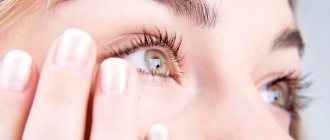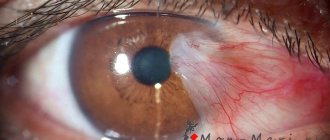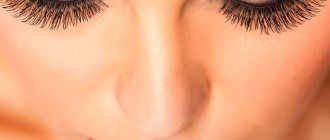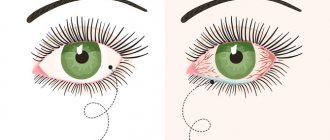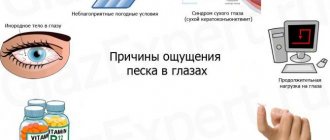Welding work entails the risk of damage to the ocular mucosa. Doctors call eye burns after welding electroophthalmia. The disease can begin if welding equipment is used incorrectly or carelessly. To prevent injury and not get burned, you need to follow safety rules.
Painful sensations in the eye occur due to the fact that ultraviolet rays affect the cornea. The degree of injury depends on their intensity.
Symptoms of electroophthalmia
There are four stages:
1. Lightweight. The symptoms are:
- burning in the eyes;
- the conjunctiva turns red;
- eyelids itch;
- clouding of the corneal area.
2. Average. Symptoms:
- strong pain;
- increased reaction to light exposure;
- the appearance of a film on the conjunctiva;
- the occurrence of deformation of the corneal region.
3. Heavy. Symptoms:
- the corneal tissue becomes very cloudy;
- prolonged pain;
- swelling of the eyelids;
- blurred vision;
- a feeling that a foreign body has entered the organ of vision.
4. Extremely heavy. The symptoms are as follows:
- continuous pain, difficulty opening the eyelids;
- the beginning of tissue death;
- conjunctival necrosis;
- partial blindness;
- faded and colorless corneal tissue.
Degrees of burns, their signs
There are four degrees of this condition:
- Easy. Accompanied by a burning sensation in the eyes and mild itching. The eyeball turns red. A burn to the cornea of the eye is characterized by slight clouding.
- Average. Photophobia occurs, it hurts the eyes greatly, and there is profuse lacrimation. The victim constantly sees “bunnies” before his eyes. Due to damage to the cornea, a film forms on the conjunctiva.
- Heavy. There is clouding of the cornea, swelling of the eyelids is observed. They swell a lot. The eyes hurt badly, the discomfort is continuous. The victim has a sensation of sand in the eye. Vision deteriorates rapidly.
- Extremely heavy. The pain in the eyes after welding is unbearable. A person cannot open them. The cornea is covered with a colorless film. She starts to look faded. Death of eye tissue occurs. The person completely loses vision.
For each stage of the phenomenon, a special treatment has been developed. The victim in all cases needs help.
First aid to the victim
What to do if welding gets into your eyes? It is imperative to contact an ophthalmologist. He will assess the degree of erosion of the corneal tissue. Before contacting an ophthalmologist, you can use:
- dark glasses, night lights, curtains, darkening glasses;
- anti-inflammatory drugs, analgin;
- natural tear products.
Caution must be observed in the first days after signs of a retinal burn appear. The use of dark glasses, avoidance of too bright lamps, and covering the windows with curtains help alleviate the condition of a welder who has burned his visual organs.
To provide first aid to the victim, wash his damaged organs with plenty of clean water, remove metal particles (if any) from them using a cotton swab. Place a cold compress on your eyelids (for ten minutes).
Do not wear blindfolds over your eyes. They lead to a slowdown in the regeneration of corneal tissue and the occurrence of unpleasant sensations. To eliminate pain, you can take Ibuprofen, Nimesil, Diclofenac (one tablet twice a day after meals, the duration of treatment is three days).
To speed up the regeneration of the epithelial layer and prevent dryness of the corneal tissue, you can treat with natural tears. They are dripped 1 drop every couple of hours.
Consequences of eye burns
With timely treatment of superficial burns, they do not have any consequences in the future. The eye recovers within a few weeks, and acute reactions (pain, redness, feeling of “sand”) subside within a few days. To speed up regeneration, you can use Etaden or Etadec-MEZ drops, which stimulate metabolism in the tissues of the cornea and conjunctiva
After damage to the retina, as a rule, the patient's vision begins to decline irreversibly. The consequences of such an eye burn are blindness, decreased quality of life and loss of professional suitability (for some specializations). All these phenomena can be eliminated with the help of an operation that is performed in regional ophthalmological centers - retinal transplantation. Modern technologies make it possible to restore a person’s vision within a few weeks of hospitalization.
Unfortunately, such medical care is practically not funded by the state, so the patient has to be treated at his own expense.
Treatment with medications
If an eye burn occurs from welding, how to treat it? If a worker burns his eyes while welding, he can be treated at home. The operation should be done only in very complex cases. The treatment process is based on the following activities:
- The use of antibiotics to accelerate the regeneration of corneal tissue, prevent keratitis, conjunctivitis (administer one drop six times a day for 5–7 days).
- The use of drops that constrict blood vessels. They should be used if the organs of vision are swollen, inflamed, or red. Instillation must be performed three times a day.
- Application of Lidocaine, Tetracaine, Novocaine. These products relieve itching and have an anesthetic effect. Use them twice a day.
For welding burns, eye drops should be used for seven days, 4 to 5 times daily. Thanks to their use, pain is reduced, corneal tissue is quickly restored, and infection is prevented.
What to do if you burn your eye due to welding? Having grabbed the “bunnies”, you should use the following drugs:
- Tobrex;
- Gentamicin;
- Tobramycin;
- Oftaquix;
- Levofloxacin.
How to determine the type of burn
The symptoms of eye burns for different types are very similar, and they should be provided first aid and treated differently. What to do in such a situation? There are special signs that make it quite easy to determine the real cause of the burn. To do this, you need to carefully question and examine the patient to detect differences.
| Distinctive feature | Thermal burn | Ultraviolet burn |
| Time of onset of symptoms | Immediately after contact with a hot substance in the eye area | No less than 4 hours later |
| What parts of the eyes are affected? | Most often, one of the following structures is affected:
| As a rule, ultraviolet radiation from welding damages all parts of the eye (except the retina) at the same time. With severe exposure, the burn can even affect the retina. |
| Symptom severity | Depends on the amount of hot substance that gets into the eye and the duration of its exposure. The following degrees of damage are distinguished:
| Most often, ultraviolet burns slightly affect the structures of the eye, so the symptoms are mild. An exception is a retinal burn. With this pathology, all symptoms appear in full force. |
| Duration of symptoms | From a few days to the end of the patient's life | Symptoms decrease after a few hours (exception: retinal burn) |
Diagnosis of eye burns during welding is carried out on the basis of patient complaints and the above symptoms. Laboratory and instrumental methods, as a rule, are not of fundamental importance.
Traditional methods
Tea
If your eyes are burned by welding, you can do the following: Brew the tea bags and wait until they cool to room temperature. Apply them to the damaged organs for fifteen to twenty minutes, then replace. You can also brew and strain loose leaf tea. Make gauze and cotton swabs, soak them in tea, and apply to the cornea. This will help narrow the conjunctival vessels and eliminate pain.
Potato
If you get a burn, then make a potato mask. Take a couple of raw potatoes and grate them on a coarse grater. Make a multi-layer bandage from gauze, put grated potatoes on it, wrap it, and apply it to the organs of vision for half an hour. This will significantly reduce pain, eliminate swelling, and cool the affected areas.
Honey
Mix two tablespoons of honey with heated boiled water. Make cotton swabs, moisten them with the solution, and place them on the places where sparks hit. Change the poultice every half hour. Honey perfectly eliminates pain and redness. It is especially useful when there is pain in the eyes.
Chamomile
Chamomile is optimal for those who have burned their eyes. Mix a couple of tablespoons of chamomile with one tablespoon of boiling water. Let the mixture sit for ten minutes, then cool to room temperature. Apply the mixture to the cornea, replacing the compress every quarter of an hour.
Aloe
Cut fresh aloe leaves and mix them with warm boiled water. Let the mixture sit for a couple of hours, then make bandages out of it. Soak cotton swabs in the solution and apply to the cornea. Aloe juice perfectly fights various inflammatory processes. You can also mix the juice of this plant with honey, drop the mixture twice a day, one drop at a time.
Oak
Oak bark has long been famous for its medicinal qualities. Therefore, if your eyes hurt from boiling, you can make a tincture of three tablespoons of oak bark. Mix it with a cup of boiled water, let the mixture brew. After three hours, soak cotton swabs and apply them to your eyes for twenty minutes.
Cabbage
This vegetable is available in any home. Cabbage perfectly relieves pain, if, of course, it is fresh. Grind a few cabbage leaves in a meat grinder. Apply the resulting pulp to the injured organs. You will feel cool, get rid of pain and inflammation.
Decoctions
Use a herbal decoction made from chamomile, linden, and calendula. There should be as many of each plant as the others. Mix herbs with 0.5 l. boiling water Wash your eyes with the decoction every couple of hours.
Eyes hurt after welding, what to put in drops
If welding causes pain in the eyes, doctors diagnose electroophthalmia.
The main cause of the condition is a violation of safety regulations, namely performing work without a protective mask or glasses.
When welding is performed, the electric arc emits ultraviolet radiation. It is dangerous for the corneal mucosa due to physical burns. Severe pain is explained by the increased sensitivity of the cornea.
The symptoms of electroophthalmia depend on the degree of eye damage. For example, with a slight burn of the corneal tissue, the victim experiences itching and burning. The doctor determines a decrease in the transparency of the cornea.
A moderate degree of corneal burn by electric welding is characterized by several signs:
- Photophobia.
- Corneal erosion.
- Severe pain.
- Film on the conjunctiva.
- Flashing “bunnies” before the eyes.
Severe eye injury from welding is indicated by symptoms such as:
- Nagging pain.
- Swelling of the eyelids.
- Decreased visual acuity.
- Sensation of a foreign body under the eyelid.
- Significant clouding of the cornea.
4th degree of burn injury from welding gives the most severe consequences:
- Blindness.
- Retinal damage.
- Necrosis of ocular tissues.
- Conjunctival rejection.
- Fading and colorlessness of the cornea.
- Severe pain that prevents you from opening your eyes.
Video:
If your eyes ripple after welding, there is a feeling of sand, pain and any discomfort, the victim must be given first aid. It consists of washing the eyes with a solution of manganese or a large amount of clean, cooled water after boiling. Small particles are removed from the eyes with tweezers or a damp cotton swab.
What eye drops can be used immediately after welding? For workers who have received a burn, doctors recommend numbing the cornea with Lidocaine (2% solution).
If metal shavings cannot be removed from the affected organ, the patient is given an injection with soluble calcium - this will help cleanse the mucous membranes. Then an antiseptic (tetracycline ointment) is placed under the eyelids.
For anti-inflammatory drugs, the victim is given Tavegil or Diclofenac, and for oral painkillers - Analgin, Ketanov.
If the cornea is burned, it is strictly forbidden to rub your eyes. A person’s attempt to alleviate the condition in this way leads to increased itching and causes blepharospasm. Additional injury to the cornea creates even greater discomfort and provokes inflammatory reactions.
If a patient has seen enough welding and his eyes hurt, treatment will be carried out at home.
Surgery is justified only in severe cases. Home therapy is based on the following activities:
- The use of antibiotics to accelerate the healing of the cornea and prevent keratitis and conjunctivitis (5 – 7 days with the administration of the drug, 1 drop up to 6 times a day).
- The use of eye drops with a vasoconstrictor effect. They relieve swelling, inflammation and redness. The first few days after the injury, eye drops are applied up to 3 times a day.
- Use of anti-inflammatory and painkillers. Lidocaine, Tetracaine and Alcaine eliminate itching and work like anesthetics, creating a freezing effect. They are used no more than 2 times. in a day.
All drugs that are suitable for the treatment of electroophthalmia are divided into several groups. They are prescribed by a doctor to achieve different therapeutic goals. Buying drops at random is unacceptable.
Let's list what you can put in your eyes after welding to eliminate swelling and inflammation:
- Visine.
- Visoptician.
- Octilia.
- Prokulin.
Following the instructions, the products are administered 1 drop 3 times. in a day. The maximum duration of treatment is 3 days. During this time, burning, itching, swelling, and redness should disappear. For inflammation of the eyes after a burn, Indocollir, Prenacid and Diclofenac (an analogue of Diclofenac) are also used.
eye drops for welding bunnies are prescribed for 1 week, using 4 to 5 times a day. The effectiveness of their use is manifested by a reduction in pain, rapid restoration of the cornea and prevention of bacterial infection.
Antibacterial drops against electroophthalmia:
- Tobrex.
- Gentamicin.
- Tobramycin.
- Oftaquix.
- Levofloxacin.
Anti-inflammatory powders and tablets Indomethacin and Nimesil for eye damage from electric welding, take 2 r. per day for 2 – 3 days. The purpose of the products is to drive away the “bunnies”, reduce pain and relieve inflammation.
Video:
After an accident, not every worker knows how to treat an eye burn from welding at home. Therefore, if you cannot visit a doctor in the near future, you need to use folk remedies to alleviate the condition.
Vasoconstriction can be achieved by tea leaves or cooled tea bags. Warm lotions with tea relieve swelling and redness. The crumbly tea leaves are placed in a gauze bag, brewed and applied to the eyes.
For eye burns, chamomile flowers and butter help quickly relieve inflammation:
- Two large spoons of herbal raw materials are steamed with boiling water and after 10 minutes, cotton pads are soaked in the liquid and placed on the eyes.
- Chamomile infusion is combined with 2 tbsp. butter, stir and make applications. Butter can be alternated with vegetable oil.
Honey in the treatment of electroophthalmia is used following this folk recipe:
- In the amount of 1 - 2 tbsp. The beekeeping product is placed in warm boiled water and stirred thoroughly.
- A cotton pad is generously moistened with a sweet solution and applied to the diseased organ.
- Remove the decongestant compress after 30–40 minutes.
When your eyes burn after cooking, folk healers recommend potato masks. 2 – 3 root vegetables should be grated on a coarse grater and the pulp should be placed in a multi-layer gauze bandage. The compress is applied for half an hour. It eliminates swelling, reduces pain and creates a cooling effect. Cabbage leaves are also used for this purpose (the raw material is passed through a meat grinder).
Continuing the topic “What to do if your eyes hurt from welding,” we will consider the option of treating electroophthalmia with the help of aloe.
Fresh healthy leaves are finely chopped and poured with warm boiled water. After 2 hours, the extract is used for compresses, applying moistened tampons to the eyes.
Another aloe remedy is prepared by mixing the sap of the plant with honey. In the morning and evening, 1 drop of the homemade drug is injected into the eyes.
If you cannot eliminate the “bunnies” and pain in the eyes after welding on your own, the victim should consult a doctor.
After all, it is possible that unfavorable changes are already occurring in the visual system. Complications of a burn can include clouding, erosion and ulceration of the cornea, decreased visual acuity and keratitis.
To avoid new problems, a person urgently goes to an ophthalmologist if the pain becomes unbearable and the discomfort is either continuous or lasts longer than 3 days. If immediately after a burn the victim notices a sharp drop in vision, you should contact a specialist on the same day.
(
ratings, average:
out of 5)
Welding is not the safest procedure. There are many safety rules. Ordinary carelessness can lead to injury. Just look at welding without glasses.
When your eyes hurt after welding, doctors diagnose electroophthalmia. Basically, it happens if safety precautions were violated, that is, the welder worked without a special mask and glasses. When metal is welded, the electric arc emits ultraviolet light. The corneal mucosa can get burned because of this. Severe pain in the eyes is due to the high sensitivity of the organs of vision.
All drugs used to treat electroophthalmia are divided into different categories. They are prescribed by a doctor; it is not recommended to use the drugs without consulting a doctor.
The symptoms that occur with this disease depend on how damaged the organs of vision are. For example, with a minor injury to the eyes, the welder feels itching, burning, and watery eyes. The doctor notes a decrease in the transparency of the corneal tissue.
With moderate injury, the following symptoms appear:
- fear of light;
- corneal erosion;
- severe pain;
- film on the conjunctiva;
- flickering “bunnies”.
The following signs indicate significant damage:
- It's a dull pain;
- swelling of the eyelids;
- decreased visual acuity;
- sensation of a foreign element under the eyelid;
- cloudy corneal tissue.
A fourth degree burn is characterized by:
- blindness;
- damaged retina;
- necrosis of eye tissue;
- rejection of the conjunctiva;
- faded, colorless cornea;
- significant pain that does not allow you to open your eyes.
What to do if your eyes hurt from welding? What should you do if your eyes ripple, it seems like there is sand in them? The person needs medical assistance. Eyes must be rinsed with manganese solution or boiled, cooled water. Small particles are removed with tweezers or a moistened cotton swab.
What eye drops can be applied immediately after welding? To relieve pain, doctors advise anesthetizing the corneal tissue with lidocaine (2% solution). If metal shavings cannot be removed from the injured organ, the person is injected with a calcium solution. This makes it possible to clean the mucous membranes. After this, an antiseptic (tetracycline ointment) is placed under the eyelids.
How to prevent inflammation if your eyes hurt after welding? You need to use tavegil, diclofenac, analgin, ketanov. If you catch bunnies, you shouldn’t rub your eyes. Otherwise, the itching will intensify and blepharospasm will occur. Additional damage to the corneal tissue will increase discomfort and provoke inflammation.
You should also not do the following:
- Use inappropriate means. There is no need to administer whatever comes to hand (albucid, other drops). The drugs may contain preservatives that negatively affect the condition of the corneal tissue and provoke inflammation.
- Wash injured areas with tap water. The water contains chlorine, magnesium, and calcium elements that irritate the cornea.
- Look at the bright light. It is best to stay in a darkened room with the curtains drawn and the lights turned off.
If a person has seen enough of welding, he is given help at home, outside of a hospital setting. The exception is severe cases when surgery is necessary. Home treatment includes:
- The use of antibiotics that accelerate the restoration of corneal tissue, helping to prevent keratitis, conjunctivitis (5-7 days you need to administer one drop of antibiotic six times daily).
- Using eye drops that constrict blood vessels. Welding eye drops eliminate swelling, redness, and stop the inflammatory process. The first few days after injury, drops are instilled up to three times daily.
- The use of anti-inflammatory and painkillers. Lidocaine, tetracaine, alcaine relieve itching, act as anesthetics, freezing the damaged organ. Use them no more than twice a day.
If your eyes hurt from welding and you need to eliminate swelling and stop the inflammatory process, you can use:
- Visine;
- visoptician;
- octilia;
- proculin.
These medications are instilled one drop three times a day. Treatment should last no longer than three days. During this period, burning, itching, swelling, and redness should disappear. You can also use indocollir, prenacid, diclofenac.
If a worker was looking at welding and caught “bunnies,” then to get rid of them, you need to instill drugs recommended by the doctor. Usually they are dripped for seven days, five times daily. The effect of their use is that pain is reduced, corneal tissue is quickly restored, and infection is prevented.
There are the following antibacterial eye drops for welding:
- tobrex;
- gentamicin;
- tobramycin;
- Oftavix;
- Levofloxacin.
Anti-inflammatory powders and tablets (indomethacin, nimesil) for eye damage from welding are taken 2 times a day for three days. The purpose of the drugs is to eliminate “bunnies”, reduce pain, and stop the inflammatory process.
If your eyes hurt from welding, what should you do? Not every welder knows this. In view of this, if you cannot go to the hospital, you can use traditional methods of treatment.
Tea leaves and used tea bags have a vasoconstrictor effect. Warm tea lotions eliminate swelling and redness. The crumbly tea leaves are placed in a gauze bag, brewed, and applied to the injured organs.
How to treat eyes from welding if they are burned? You can use chamomile flowers and butter.
- Pour boiling water over 2 tablespoons of chamomile. After ten minutes, moisten the cotton wool discs with the resulting mixture. Place them on your eyes.
- Mix chamomile infusion with a couple of tablespoons of butter and make applications. You can replace butter with sunflower oil.
Honey can be used like this:
- Place a couple of tablespoons of honey in warm boiled water and mix well.
- Wet a cotton pad with the resulting solution and place it on the injured eyes.
- Remove the disc after half an hour.
My eyes hurt after welding, what should I do? If you feel a strong burning sensation, you can use potato masks. Grate 2-3 potatoes on a coarse grater. Place the grated potatoes in a gauze bandage with many layers. Apply the blindfold to your eyes for thirty minutes. Thanks to such a compress, you will get rid of swelling, reduce pain, and feel cool. You can also use cabbage leaves that have been minced through a meat grinder.
For those who have caught bunnies from welding, there is a folk method of treatment that uses aloe. The leaves are cut and poured with heated boiled water. After two hours, the extract is used as a compress by placing moistened swabs on the organs of vision.
Another remedy from aloe can be prepared by mixing its juice with honey. After waking up and before going to bed, the product is instilled into the eyes, one drop at a time.
Oak bark is known for its medicinal properties. To heal the eyes, you can use a tincture of three tablespoons of oak bark. Moisten cotton swabs with it and place on the injured areas for twenty minutes.
If you cannot get rid of pain on your own, you need to go to the doctor. There is a possibility that negative changes have begun. The injury can be complicated by opacification, erosion and ulceration of the corneal tissue, decreased visual acuity and keratitis.
To prevent various complications, the injured person should immediately go to the ophthalmologist if:
- the pain is unbearable;
- the pain does not stop;
- the pain continues for more than three days.
If, after being injured, a worker notices a significant deterioration in vision, you should see a doctor immediately.
Symptoms of injury usually appear after 5-6 hours. If the burn is mild, the treatment is carried out correctly, they disappear after a couple of days. In difficult cases, treatment will take approximately half a month. It is necessary to take medications until complete recovery.
To avoid problems with your vision, use specialized equipment and follow safety regulations. This way you will save your own health and the time spent on treatment and going to hospitals.
If you do pick up “bunnies”, and the injury is not too serious, begin home treatment with medications. It is better to use those means that are considered the most effective. If medications do not relieve you of pain and discomfort, you can try treatment with traditional methods. However, no one guarantees that it will help you. So it is better to be treated with official medicine.
In the event of a serious injury, you must immediately contact an appropriate specialist at the clinic. Previously, he was called an “ophthalmologist,” now an “ophthalmologist.” The most severe burns may require immediate surgery. The sooner all the necessary procedures are carried out, the higher the likelihood of avoiding chronic problems with the organs of vision in the future (decreased visual acuity, dry eyes, glaucoma, other eye diseases).
A number of professions can be classified as at risk for eye damage. The leading position is occupied by the welder. Eye pain often occurs as a result of welding work. They are called electroophthalmia. It can manifest itself in different ways, depending on the degree of damage.
My eyes hurt after welding: what to do?
Not only professional welders can have eye pain. Anyone is susceptible to the negative effects of welding if they work with a welding machine.
Pain in the eyes after welding occurs due to a banal failure to comply with safety rules. To protect your eyesight, you must wear a special mask or goggles. They have special glass that minimizes the impact of welding on the eyes. If you ignore this rule, then a retinal burn occurs. Symptoms of the lesion can manifest themselves in different ways. They depend on the degree of burns. There are 4 degrees of retinal burn:
| Mild degree | Characterized by mild burning, redness and itching of the eyes, clouding of the cornea |
| Average degree | Symptoms are as follows: sharp pain, severe sensitivity to light, erosion of the ocular cornea, formation of a film on the conjunctiva |
| Severe degree | It manifests itself in the form of severe clouding of the cornea, swelling of the eyelids, blurred vision, and nagging pain. Often there is a sensation of the presence of a foreign body in the eye |
| Extremely heavy | The last degree is characterized by extremely severe and unpleasant sensations and pain. Complete blindness occurs, the cornea becomes colorless, the conjunctiva gradually begins to die, and tissue necrosis occurs. Severe pain in the eyes prevents you from opening your eyelids |
Pain in the eyes occurs as a result of exposure to ultraviolet rays on the cornea, which occur during welding work. And the more intense the radiation, the more severe the burn the organ of vision receives. It is worth remembering that excessive exposure to ultraviolet radiation can lead to complete loss of vision.
Often people who carry out welding work simply do not pay attention to the pain in their eyes. But this is completely wrong. First aid for a burn will not only help minimize the negative effects of ultraviolet radiation on the cornea, but also help save vision.
First aid for corneal burns
A cold compress applied to the eyes is very effective. You need to hold it for 5-10 minutes.
You also need to do the following:
- It is necessary to take a pain reliever and anti-inflammatory drug. In the first case, you can use Analgin or Ketonal, in the second - Tavegil or Diclofenac.
- Eyes should be rinsed thoroughly with clean water (not tap water).
- If metal elements or shavings get into your eyes, they must be removed with a cotton pad. If there are still metal particles in the organ that cannot be removed on your own, you should consult a doctor.
- Next, apply a cold compress to your eyes.
- After the compress, the eyes should be smeared with antiseptic ointment. Tetracycline is excellent.
After carrying out all these steps, you need to contact an ophthalmologist. Only a specialist will be able to conduct the necessary examinations, diagnoses and prescribe medications for eye treatment.
A burn is a thermal injury to tissue. Traumatic factors, even minor ones, violate the integrity of the tissues of the eye: the cornea and conjunctiva, which is manifested by swelling, redness, pain and burning, and the sensation of a foreign body in the eye. To restore eye tissue after injury, products containing dexpanthenol, a substance characterized by a regenerating effect on tissue, have proven themselves to be effective, in particular, the Korneregel eye gel. It has a healing effect due to the maximum concentration of dexpanthenol 5%*, and the carbomer included in its composition, due to its viscous texture, prolongs the contact of dexpanthenol with the ocular surface.
*5% is the maximum concentration of dexpanthenol among ophthalmic forms in the Russian Federation. According to the State Register of Medicines, State Medical Devices and Organizations (individual entrepreneurs) engaged in the production and manufacture of medical devices, as well as data from open sources of manufacturers (official websites, publications), April 2017
There are contraindications. You need to read the instructions or consult a specialist.
Actions that absolutely cannot be performed with electroophthalmia
If a person begins to experience pain due to welding work, that is, signs of electroophthalmia appear, then doctors categorically prohibit the following actions:
- Rub your eyes. With corneal burns, there is often a feeling that there is a foreign body in the eye. And if the victim begins to intensively rub his eyes, he creates favorable conditions for the further development of the disease;
- Use eye drops. Many products are designed to relieve fatigue. They often contain preservatives, which negatively affect the diseased cornea and contribute to the further development of inflammation;
- Rinse eyes with tap water. First of all, you need to use clean bottled water. The liquid from the tap contains a huge amount of impurities: chlorine, calcium, rust, sand, which only irritate the mucous membrane of the eye.
Treatment of eye burns can be conservative or surgical. Surgical intervention is used as a last resort, in cases of particularly severe burns. The use of laser eye microsurgery shows the greatest effectiveness. In other cases, they resort to a more loyal conservative method.
Conservative methods of treating corneal burns include the use of various medications. Each specific type is designed to eliminate one or another symptom. Therefore, complex treatment is prescribed, that is, the use of several medications at once. Naturally, it is necessary to use all remedies only after consulting a doctor.
Consult your doctor before using medications
For treatment use:
- eye drops to eliminate swelling and inflammation. The most commonly used drugs are Vizin, Visoltin, Proculin. It is necessary to instill one drop 3 times a day. The duration of the course should not exceed 3 days. Help relieve swelling, eliminate itching, burning and redness;
- anesthetic eye drops. These include Alcaine, Tetracaine, Lidocaine. One drop should be instilled into each eye 2 times a day. The course lasts only 2 days. You can continue to use it, but only after consulting your doctor. The product helps relieve pain and promotes healing of the cornea;
- eye antibiotics. These include Gentamicin, Levofloxacin, Tobramycin, Tobrex. Apply the product 4 times a day. Course duration – 7 days. Medicines in this group also relieve pain symptoms and improve the condition of the cornea;
- anti-inflammatory drugs. Promote the restoration of the mucous membrane, and are a preventive measure against the risk of complications. They can be in the form of tablets (Diclofenac, Indomethacin), powder (Nimesil), eye drops (Clodifen).
Consult your doctor to prescribe treatment
Once again, it is worth recalling that all medications, dosage and course duration are prescribed by an ophthalmologist.
Traditional medicine is not an alternative to visiting a doctor. The products can only be used as additional restorative and strengthening agents. The most effective means include:
| Decoctions of linden, calendula and chamomile | The eyes are washed with infusion 3-4 times a day. |
| Potato compress | The raw vegetable is grated, placed on gauze and applied to the eyes. You need to keep the compress for 10 minutes |
| Aloe and honey | The plant juice is mixed with honey in a 1:1 ratio and one drop is instilled 2 times a day. Helps relieve inflammation, restores the epithelium. It is not recommended to use the composition within the first 24 hours after receiving a burn. |
If measures are not taken in time to treat eye burns after welding, the consequences can be quite severe. Thus, complications such as:
- astigmatism;
- blurred vision;
- keratitis, that is, chronic inflammation of the ocular cornea;
- erosion and ulcers on the cornea;
- corneal turbidity.
Severe and extremely severe burns, even with timely treatment, can lead to such unpleasant consequences as endophthalmitis and even complete loss of vision.
Use a special mask to avoid serious consequences
To reduce the risk of welding injury, safety precautions must be followed. When working, be sure to use a special protective mask or safety glasses. To increase the level of safety, you need to use serviceable welding equipment and high-quality electrodes. All this reduces the amount of metal splashes in the air. Parts that are being processed must be protected from dirt and rust.
If a burn does occur, it is necessary to immediately provide first aid to the victim and then take him to the hospital. Only in this case will the patient’s speedy recovery be guaranteed, and the risk of complications will be minimized.
| Lightweight | Burning, redness, itching, clouding of the cornea |
| Average | Severe pain, sensitivity to light, corneal erosion, film on the conjunctiva |
| Heavy | Severe clouding of the cornea, blurred vision, swelling, severe nagging pain |
| Extremely heavy | Blindness, the cornea becomes colorless, tissue necrosis, death of the conjunctiva |
The eyes are the most vulnerable human organ. Therefore, when working with welding, be sure to wear goggles or a protective mask. Those who ignore safety precautions when working with a welding machine, sooner or later may, as professionals say, “catch bunnies” and face electroophthalmia and eye burns. Burns to the eyes during welding can be aggravated by the ingress of hot pieces of metal, dust and smoke into them.
Ultraviolet radiation has a dangerous effect on the mucous membrane of the eyes, cornea and lens. Not only welders, but also solarium visitors and those who work with ultraviolet radiation can get burned. Electroophthalmia can be aggravated by hot pieces of metal, dust and smoke getting into the eyes.
When welding, an electric arc appears, emitting powerful ultraviolet radiation. It is this that negatively affects the eyes, which are already strained by working with small details.
A retinal burn causes unbearable pain to a person, due to which he may partially lose vision, peace and sleep.
If your eyes hurt after welding, then you should quickly provide first aid to the victim in order to at least slightly reduce the pain. Symptoms of electroophthalmia are as follows:
- Sharp pain when blinking;
- Redness and swelling of the eyes;
- Cloudiness of the cornea;
- Burning and itching;
- Photophobia.
What to do if your eyes hurt from welding? The first and most important rule is that the eyes should not be disturbed or rubbed; they should be rinsed with distilled water . Tap water is not suitable, as it may contain chlorine and other harmful substances that can damage the irritated cornea. Assistance must be provided under sterile conditions so as not to aggravate the already serious condition of the eyes and not to cause infection.
The patient can be given painkillers and anti-inflammatory drugs, and a sterile compress of cold water or chamomile infusion can be applied to the eyes. Bandages need to be changed periodically. An antiseptic, such as tetracycline ointment, or drops that prevent the development of infection (albucid) can be applied to the affected area.
Attention! After providing first aid, you should consult a doctor. An eye burn can lead to partial or complete loss of vision. Treatment for eye burns by welding
To treat an eye burn from welding, you need to find out how badly the eyes are damaged. There are 4 degrees of burn:
- Mild burn
- Average degree
- Severe degree
- Extremely heavy
Depending on the degree of damage, medical care can be of two types: conservative and surgical. Surgical intervention is necessary in extremely severe cases of electroophthalmia; one of its methods is laser eye microsurgery.
In other cases, you can treat an eye burn from welding by:
- Painkillers to relieve itching and pain;
- Eye drops that have a vasoconstrictor effect;
- Eye antibiotics that accelerate corneal healing;
- Anti-inflammatory drugs that relieve inflammation and reduce pain.
If your eyes hurt after welding, and there is no way to see a doctor, then folk remedies will help relieve the pain and relieve inflammation. This does not apply to cases where the burn is severe. Eye burns from welding can be treated with compresses, lotions and masks, which are applied to the affected eyelids.
- Regular tea will help relieve pain and inflammation of the conjunctiva . Tea bags need to be brewed and cooled, after which they can be placed on the eyes. If there are no tea bags, then a simple brew will do; tampons soaked in it are placed on the eyelids for 10-15 minutes, after which they are changed.
- Eye lotions made from linden tea will help relieve swelling and inflammation from sore eyes. They can be alternated with calendula infusion for greater effectiveness.
- Raw potatoes effectively treat eye burns from welding; they need to be grated and placed on cheesecloth. The blindfold is changed after half an hour.
- Honey compresses relieve redness and swelling of the eyes. A tablespoon of honey is dissolved in a glass of warm water, soaked gauze or a compress is applied to the affected area.
- If you have picked up some welding, but there are no medicines at hand, then cabbage leaf . It can be crushed into a paste or applied whole; it will cool the inflamed areas and relieve swelling.
- When your eyes hurt from welding, cut into small pieces and soaked in water for 2 hours can help You need to infuse the folk remedy for a couple of hours, after which use the infusion for compresses.
Important! Before treating electroophthalmia with folk remedies, it is necessary for at least 24 hours to pass from the moment of the burn.
To normalize the condition of a patient who has looked at welding, eye drops are used. It is strictly contraindicated to use the first available medications that you find in your first aid kit.
Those who have looked at welding are usually prescribed:
- Drops that relieve swelling and inflammation;
- Anesthetic drops;
- Antibiotics.
An ophthalmologist should prescribe eye drops and the duration of their use.
The main precaution and prevention measure that will protect your eyes from burns is wearing a protective mask or glasses. Wearing protection should not be neglected even in cases where you are just standing nearby.
Symptoms of a burn appear after 5-6 hours; with a mild burn and proper treatment, they will disappear after 2-3 days. For moderate, severe and extremely severe burns, recovery will not occur earlier than in a week or two. Taking medications should be continued until complete recovery, and not stopped even after symptoms have eased.
The consequence of a severe or extremely severe burn can be a decrease in visual acuity, the development of dry eye syndrome, glaucoma and other eye diseases.
What is prohibited with electroophthalmia
To prevent unpleasant consequences, a worker who has burned his eyes should not do the following:
- Rub your eyes. The first sign that a person has burned their eyes is the sensation of a foreign object. Rubbing often leads to damage to the conjunctival film. There is an increase in pain and inflammation.
- Apply drops frequently. Medicines purchased without knowing the exact diagnosis can cause irritation. The use of untested, dubious folk methods can aggravate the situation.
- Rinse the visual organs with tap water. Typically, tap water contains dirty impurities and various elements that irritate the conjunctiva. What to do when welding gets into your eyes? Use purified distilled water.
Chemical burn to the eyes
This type of damage is much more dangerous than exposure to scale or exposure to ultraviolet radiation. Eye burns from chemicals manifest themselves with the same symptoms as after welding. However, there is one important difference - in 85% of cases the damage is deep and irreversible.
In principle, chemical burns are divided into acid and alkaline.
Alkali burn
Typical representatives of alkalis are soda, lime, ammonia solutions, and cleaning products. They are present in every person’s everyday life, and are extremely dangerous if they come into contact with the eyes. The fact is that alkalis enter into chemical reactions with the conjunctiva, cornea and sclera, rapidly destroying them. Therefore, a chemical burn to the mucous membrane of the eye quickly becomes deep and damages all structures, right up to the retina.
It is quite difficult to remove alkali from fabrics, so it is important that first aid is provided as early as possible.
Acid burn
Easier to deal with than alkali damage. When acid gets in, the superficial structures of the eye are often damaged. During the chemical reaction, a lot of protein is released from the destroyed mucosa, which delays the acid on its way to the retina. Therefore, with timely assistance, visual function can be preserved.
In everyday life, the following acids are most often used:
- Potassium permanganate (synonym: potassium permanganate) - there is an additional sign that will help determine damage to manganese. At the same time, the mucous membrane turns brownish-brown;
- Vinegar;
- Nitric acid – is included in almost all solutions for cleaning metals;
- Formaldehyde is a typical component of nail polish remover;
- Lemon acid;
- Boric acid.
First aid for retinal burns
The first symptoms begin to appear 4-5 (up to 9) hours after a UV burn. There is anxiety and a feeling of itching in the eyes. The eyelids become swollen and red. A person tends to rub his eyes and remove a non-existent foreign object from under his eyelids. Later, sharp pain appears when rotating the eyeball or opening the eyelids. More severe symptoms appear progressively.
When the first symptoms appear, you should immediately contact an ophthalmologist. If this is not possible, take emergency first aid measures yourself:
- Rinse eyes with cold bottled water or tea or chamomile infusion;
- Apply a cyproplegic drug to the eyes, for example: Cyclopentanol (1%) or Tropicamide (1%).
- Apply a pressure bandage or compress to the eyes with cold astringent solutions that accelerate epithelization: Artificial tears, Korneregel (Dexpatenol 0.5%), Actovegin or Solcoseryl (eye gel), Vitamin A (Retinol).
- To relieve severe pain symptoms, you can use pain-relieving eye drops: Lidocaine, Alcaine, Tetracaine, and take analgesics in tablets: Analgin, Ketanov, Nise, etc. You can use anti-inflammatory drugs: Diclofenac, Ketoprofen.
You should not put the first eye drops that come to hand into your eyes!
For example, anti-fatigue drops such as Albucid. They contain preservatives that inhibit regenerative (restorative) processes in the retina.
You should not use eye drops and ointments containing antibiotics on your own. They can smooth out the picture of more serious inflammatory eye diseases and complicate correct diagnosis.
In what cases is it necessary to contact a medical institution?
At the beginning of the article it was already mentioned that treatment is carried out depending on the degree of eye burn. And only a qualified doctor, using special equipment, can determine the severity of the injury.
For stage 1-2 eye burns, hospitalization is not needed, but only need to follow all the instructions of the ophthalmologist, but with stage 3-4 burns, adhesions may form between the eyelid and the eyeball, so there is no need to refuse hospital treatment.
From the above it is already clear what to do if you get an eye burn. Let us now consider the duration of treatment and recovery from the injury.
If the injury was not serious and the correct first aid was provided on time, then a few days are enough to eliminate the symptoms and improve the condition of the victim.
But if following all the doctor’s recommendations does not produce results, and the condition does not improve, then it is necessary to contact the nearest medical facility again as soon as possible.
If not only the eyes are injured, but also the skin of the face or other parts of the body is burned, you must immediately call emergency medical assistance in order to receive qualified assistance and avoid complications.
